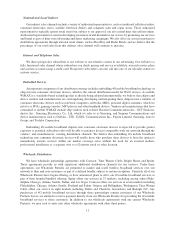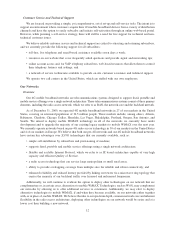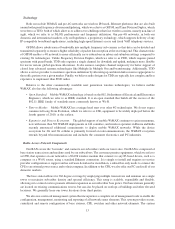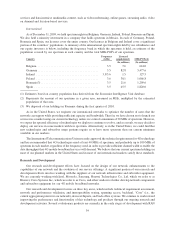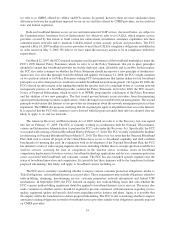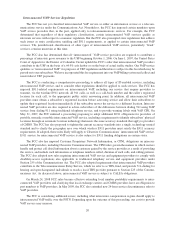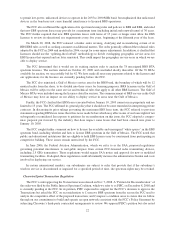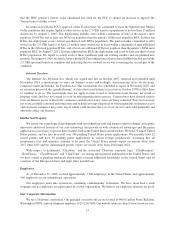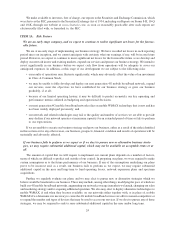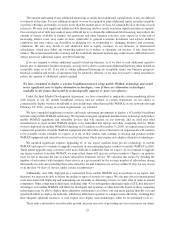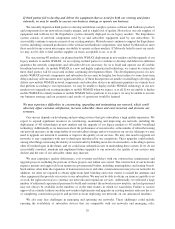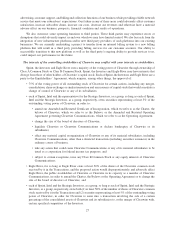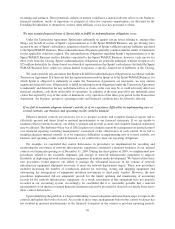Clearwire 2009 Annual Report Download - page 30
Download and view the complete annual report
Please find page 30 of the 2009 Clearwire annual report below. You can navigate through the pages in the report by either clicking on the pages listed below, or by using the keyword search tool below to find specific information within the annual report.I
nterconnecte
d
VOIP Services Re
g
u
l
ation
T
he FCC has not
y
et classified interconnected VoIP service as either an information service or a telecom-
m
unications service under the Communications Act. Nonetheless, the FCC has im
p
osed certain mandates u
p
on
V
oIP serv
i
ce prov
id
ers t
h
at,
i
nt
h
e past, app
li
e
d
on
l
ytote
l
ecommun
i
cat
i
ons serv
i
ces. For examp
l
e, t
h
e FCC
d
eterm
i
ne
d
t
h
at re
g
ar
dl
ess o
f
t
h
e
i
rre
g
u
l
ator
y
c
l
ass
ifi
cat
i
on, certa
i
n
i
nterconnecte
d
VoIP serv
i
ces qua
lify
a
s
i
nterstate services with respect to economic re
g
ulation. But the FCC also preempted state re
g
ulations that address
s
uch issues as entry certification, tariffing and E911 requirements, as applied to certain interconnected VoI
P
s
erv
i
ces. T
h
e
j
ur
i
s
di
ct
i
ona
l
c
l
ass
ifi
cat
i
on o
f
ot
h
er t
y
pes o
fi
nterconnecte
d
VoIP serv
i
ces, part
i
cu
l
ar
ly
“
fi
xe
d”
s
ervices, remains uncertain at this time.
T
he FCC also has determined that all “interconnected” VoIP service
p
roviders are re
q
uired to contribute a
p
ercenta
g
e of interstate
g
ross revenues to the USF be
g
innin
g
October 1, 200
6
. On June 1, 2007, the United States
Court of A
pp
eals for the District of Columbia Circuit u
p
held the FCC’s order that interconnected VoIP
p
rovider
s
c
ontribute to the USF on the basis of a 64.9% safe harbor or on the basis of actual traffic studies. Our VoIP servic
e
q
ua
lifi
es as “
i
nterconnecte
d
VoIP”
f
or purposes o
f
USF regu
l
at
i
on an
d
t
h
ere
f
ore
i
ssu
bj
ect to t
hi
s
f
ee w
hi
c
h
may
be
p
assed on to our subscribers. We have incorporated this fee requirement into our VoIP billin
g
s
y
stem and collect and
r
emit federal USF pa
y
ments.
Th
e FCC
i
s con
d
uct
i
ng a compre
h
ens
i
ve procee
di
ng to a
dd
ress a
ll
types o
f
IP-ena
bl
e
d
serv
i
ces,
i
nc
l
u
di
n
g
i
nterconnecte
d
VoIP serv
i
ce, an
d
to cons
id
er w
h
at regu
l
at
i
ons s
h
ou
ld b
e app
li
e
d
to suc
h
serv
i
ces. T
h
e FCC
h
a
s
i
mposed E911-related requirements on interconnected VoIP, includin
g
our service that require providers t
o
t
ransmit, via the wireline E911 network, all 911 calls, as well as a call-back number and the caller’s registere
d
l
ocat
i
on
f
or eac
h
ca
ll
,tot
h
e appropr
i
ate pu
bli
csa
f
ety answer
i
ng po
i
nt. In a
ddi
t
i
on, a
ll i
nterconnecte
d
Vo I
P
p
rov
id
ers must o
b
ta
i
nasu
b
scr
ib
er’s re
gi
stere
dl
ocat
i
on
b
e
f
ore act
i
vat
i
n
g
serv
i
ce an
d
a
ll
ow t
h
e
i
rsu
b
scr
ib
ers t
o
update their registered location immediately if the subscriber moves the service to a different location. Intercon
-
n
ecte
d
VoIP prov
id
ers are a
l
so requ
i
re
d
to a
d
v
i
se su
b
scr
ib
ers o
f
t
h
e
diff
erences
b
etween
di
a
li
n
g
911 us
i
n
g
Vo I
P
s
erv
i
ce
f
rom
di
a
li
n
g
911 us
i
n
g
tra
di
t
i
ona
l
te
l
ep
h
one serv
i
ce, an
d
to prov
id
e warn
i
n
gl
a
b
e
l
sw
i
t
h
VoIP CPE. O
n
Ma
y
31, 2007, the FCC initiated a proceedin
g
proposin
g
to adopt additional E911 obli
g
ations for providers of
p
orta
bl
e, noma
di
cormo
bil
e
i
nterconnecte
d
VoIP serv
i
ce,
i
nc
l
u
di
ng a requ
i
rement to
id
ent
if
ysu
b
scr
ib
ers’ p
h
ys
i
ca
l
l
ocat
i
ons t
h
rou
gh
an automat
i
c
l
ocat
i
on tec
h
no
l
o
gy
t
h
at meets t
h
e same accurac
y
stan
d
ar
d
st
h
at app
ly
to prov
id
er
s
of CMRS. The FCC has also proposed to ti
g
hten the current accurac
y
standards into a sin
g
le, technolo
gy
neutra
l
s
tan
d
ar
d
an
d
to c
l
ar
if
yt
h
e geograp
hi
c area over w
hi
c
h
w
i
re
l
ess E911 prov
id
ers must sat
i
s
f
yt
h
e E911 accurac
y
r
equ
i
rements. I
f
a
d
opte
d
,t
h
ese ru
l
es
lik
e
l
yw
ill
app
l
ytoC
l
earw
i
re Commun
i
cat
i
ons’
i
nterconnecte
d
VoIP serv
i
ce.
E911 service for interconnected VoIP service is also sub
j
ect to E911 fundin
g
obli
g
ations in certain states.
T
he FCC also has imposed Customer Proprietar
y
Network Information, or CPNI, obli
g
ations on intercon-
n
ecte
d
VoIP prov
id
ers,
i
nc
l
u
di
ng C
l
earw
i
re Commun
i
cat
i
ons. T
h
e CPNI ru
l
es govern t
h
e manner
i
nw
hi
c
h
carr
i
er
s
handle and protect call detail information about a customer
g
ained b
y
the service provider as a result of providin
g
t
he service, and include such information as telephone numbers called, duration of such calls, and calling patterns.
T
h
e FCC a
l
so a
d
opte
d
new ru
l
es requ
i
r
i
ng
i
nterconnecte
d
VoIP serv
i
ce an
d
equ
i
pment prov
id
ers to comp
l
yw
i
t
h
di
sa
bili
t
y
-access re
g
u
l
at
i
ons a
l
so app
li
ca
bl
e to tra
di
t
i
ona
l
te
l
ep
h
on
y
serv
i
ce an
d
equ
i
pment prov
id
ers un
d
e
r
S
ection 2
55
of the Communications Act. The FCC also ado
p
ted re
q
uirements that interconnected VoIP
p
rovider
s
c
ontribute to the Telecommunications Relay Service, which we refer to as TRS, fund, and provide 711-dialing fo
r
hearin
g
and speech-impaired individuals to reach a local TRS provider pursuant to Section 225 of the Commu
-
n
ications Act. As discussed above, interconnected VoIP service is sub
j
ect to CALEA obli
g
ations
.
On March 24, 2008 FCC rules became effective extending local number portability requirements to inter
-
c
onnecte
d
VoIP prov
id
ers an
d
c
l
ar
ifyi
n
g
t
h
at
l
oca
l
exc
h
an
g
e carr
i
ers an
d
CMRS prov
id
ers
h
ave an o
blig
at
i
on t
o
p
ort numbers to VoIP providers. In Ma
y
2009, the FCC also extended new 24-hour service discontinuance rules t
o
V
oIP
p
roviders.
Th
e FCC
i
s cons
id
er
i
ng a
ddi
t
i
ona
li
ssues;
i
nc
l
u
di
ng w
h
at
i
ntercarr
i
er compensat
i
on reg
i
me s
h
ou
ld
app
l
yt
o
i
nterconnecte
d
VoIP tra
ffi
c over t
h
e PSTN. Depen
di
ng upon t
h
e outcome o
f
t
hi
s procee
di
ng, our costs to prov
ide
V
oIP service ma
y
increase.
20



